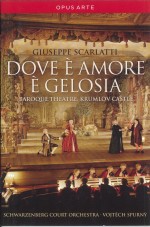 Giuseppi Scarlatti – Dove è amore è gelosia
Giuseppi Scarlatti – Dove è amore è gelosia
Lenka Máčiková; Aleš Briscein;
Kateřina Knežíková; Jaroslav Březina; Schwarzenberg Court Orchestra;
Vojtěch Spurný
Opus Arte OA 1104 D
Prince Joseph Adam of Schwarzenberg left the education of his children (nine of them by Princess Maria Theresia of Liechtenstein, since you ask) in the hands of one of the Scarlatti family, Giuseppe, probably a nephew of Domenico. Prince Joseph openly referred to his own “low-brow taste” and love for Italian opera buffa and Scarlatti obliged. Dove è amore è gelosia is a lovesick duel between the widowed Marquise Clarice (Lenka Máčiková) and her suitor Count Orazio (Aleš Briscein) who slog it out, aided by failed suicide attempts (the sword got stuck in its scabbard, you see) and cups of tea carelessly poured by Clarice’s maid Vespetta (Kateřina Knežíková) which only forestall the quarrelling and venomous name-calling.
As if that was not enough, the aristocratic dépit amoureux is parallelled by the slapstick duel between Vespetta and Orazio’s confidant Patrizio (Jaroslav Březina). All make for a classic opera buffa, what with comedies of errors, supremely beautiful trompe l’oeil scenery, stage crew in period costume driving their stage manager to the point of nervous breakdown and even musicians who look over their shoulder in amused appreciation of what is going on.
It is difficult to single out any of the singers. All convey their anguish (and their sense of joy at inflicting anguish), and their satisfaction when they have sorted out all the confusion created throughout the course of this delightful farce. Non-speakers of Italian are greatly helped by the onscreen translations, which are both blunt and priceless: the suitor’s misdirected cry of “You blockhead” is more than matched by the widow’s retort “Get lost. Out!”
And then there is the star without any singing part — Český Krumlov castle where this DVD was filmed. The theatre for this re-enactment lies off the fifth(!) courtyard and is described as a baroque stage in its mature form of 1680. Enjoy this amusing performance.



